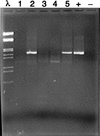Prevalence of Porphyromonas gingivalis and periodontal health status
- PMID: 9774572
- PMCID: PMC105308
- DOI: 10.1128/JCM.36.11.3239-3242.1998
Prevalence of Porphyromonas gingivalis and periodontal health status
Abstract
Periodontitis is a common, progressive disease that eventually affects the majority of the population. The local destruction of periodontitis is believed to result from a bacterial infection of the gingival sulcus, and several clinical studies have provided evidence to implicate Porphyromonas gingivalis. If P. gingivalis is a periodontal pathogen, it would be expected to be present in most subjects with disease and rarely detected in subjects with good periodontal health. However, in most previous studies, P. gingivalis has not been detected in the majority of subjects with disease, and age-matched, periodontally healthy controls were not included for comparison. The purpose of the study reported here was to compare the prevalence of P. gingivalis in a group with periodontitis to that of a group that is periodontally healthy. A comprehensive sampling strategy and a sensitive PCR assay were used to maximize the likelihood of detection. The target sequence for P. gingivalis-specific amplification was the transcribed spacer region within the ribosomal operon. P. gingivalis was detected in only 25% (46 of 181) of the healthy subjects but was detected in 79% (103 of 130) of the periodontitis group (P < 0.0001). The odds ratio for being infected with P. gingivalis was 11.2 times greater in the periodontitis group than in the healthy group (95% confidence interval, 6.5 to 19.2). These data implicate P. gingivalis in the pathogenesis of periodontitis and suggest that P. gingivalis may not be a normal inhabitant of a periodontally healthy dentition.
Figures

References
-
- Alpagot T, Wolff L F, Smith Q T, Tran S D. Risk indicators for periodontal disease in a racially diverse urban population. J Clin Periodontol. 1996;23:982–988. - PubMed
-
- Beck, J. D. 1994. Methods of assessing risk for periodontitis and developing multifactorial models. J. Periodontol. 65(Suppl. 5):468–478. - PubMed
-
- Brown L J, Brunelle J A, Kingman A. Peridodontal status in the United States, 1988–1991: prevalence, extent, and demographic variation. J Dent Res. 1996;75(Special issue):672–683. - PubMed
-
- Brown L J, Oliver R C, Loe H. Periodontal diseases in the U.S. in 1981: prevalence, severity, extent, and role in tooth mortality. J Periodontol. 1989;60:363–370. - PubMed
-
- Christopher L A, Griffen A L, Leys E J. Low incidence of colonization with Porphyromonas gingivalis among dental students. J Dent Res. 1996;75(IADR abstracts):354.
Publication types
MeSH terms
Substances
Grants and funding
LinkOut - more resources
Full Text Sources
Other Literature Sources

